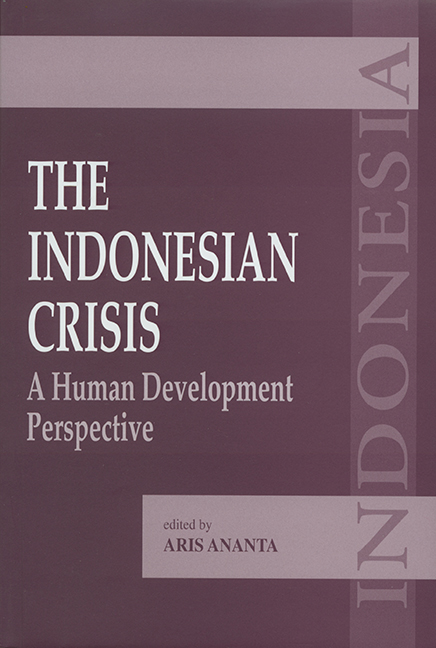Book contents
- Frontmatter
- Contents
- Acknowledgements
- List of Contributors
- Part I Introduction
- Part II Human Capital
- Part III Purchasing Power
- 9 Change in Consumer Price: Indonesian Cities, 1997–99
- 10 Social Safety Net Programmes in Indonesia: Some Efforts to Survive
- 11 State-Created Socio-Cultural Poverty: Lessons from Some Micro Studies
- 12 The Labour Market in Indonesia during the Crisis
- Part IV Emerging Issues
- Index
12 - The Labour Market in Indonesia during the Crisis
from Part III - Purchasing Power
Published online by Cambridge University Press: 21 October 2015
- Frontmatter
- Contents
- Acknowledgements
- List of Contributors
- Part I Introduction
- Part II Human Capital
- Part III Purchasing Power
- 9 Change in Consumer Price: Indonesian Cities, 1997–99
- 10 Social Safety Net Programmes in Indonesia: Some Efforts to Survive
- 11 State-Created Socio-Cultural Poverty: Lessons from Some Micro Studies
- 12 The Labour Market in Indonesia during the Crisis
- Part IV Emerging Issues
- Index
Summary
Introduction
One important aspect of the economic crisis at the macroeconomic level that would affect the quality of life of the people in Indonesia at the micro level is the adjustment in household or individual income, which depends largely on the adjustment in the labour market. A sharp economic contraction by almost 14 per cent in 1998 led to declining labour demand, massive lay-offs, and shrinking formal sector employment. Earnings in the formal sector sharply declined, and labour moved to the unprotected informal sectors. At the same time, rapid inflation of more than 77 per cent in 1998 significantly reduced the purchasing power of labour. In other words, Indonesian labourers suffered both from declining employment opportunities and skyrocketing prices, which led to rapidly declining real incomes during the worst time of the crisis in 1998.
The effects of the economic crisis, characterized by a massive contraction in the real sector, rapid inflation, and excessive depreciation of the currency, leading to a decline in the real income of Indonesian labourers, depended on the nature of the adjustments in the labour market. In other words, the characteristics and nature of the labour market matter in determining whether the impact of the economic crisis led to massive adjustments in quantity (or employment), or prices (or wages), or both. In most developed countries, and in a labour scarce economy in general, wages tend to be sticky and adjustments in the labour market mostly result in declining employment. In a laboursurplus developing country, such as Indonesia, where formal sector employment is twice as large as the informal sector, wages tend to be flexible, and adjustment to the shock would come from declining real wages. Workers could not afford to be unemployed in the absence of social security, safety nets, or other forms of insurance against unemployment.
While declining real incomes at the aggregate level can be observed easily by looking at real gross domestic product (GDP) growth, or real GDP per capita, the decline in real incomes at the micro individual or household level would not be obvious. One question, for example, is the impact of the crisis on the changing patterns of income distribution.
- Type
- Chapter
- Information
- The Indonesian CrisisA Human Development Perspective, pp. 313 - 342Publisher: ISEAS–Yusof Ishak InstitutePrint publication year: 2002

